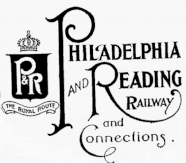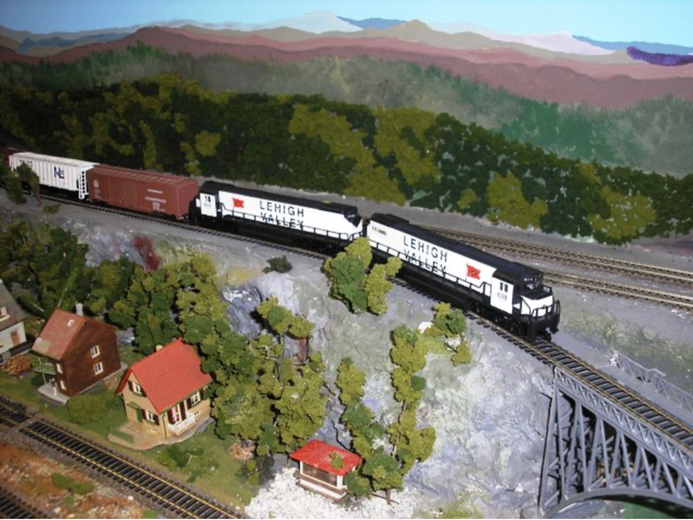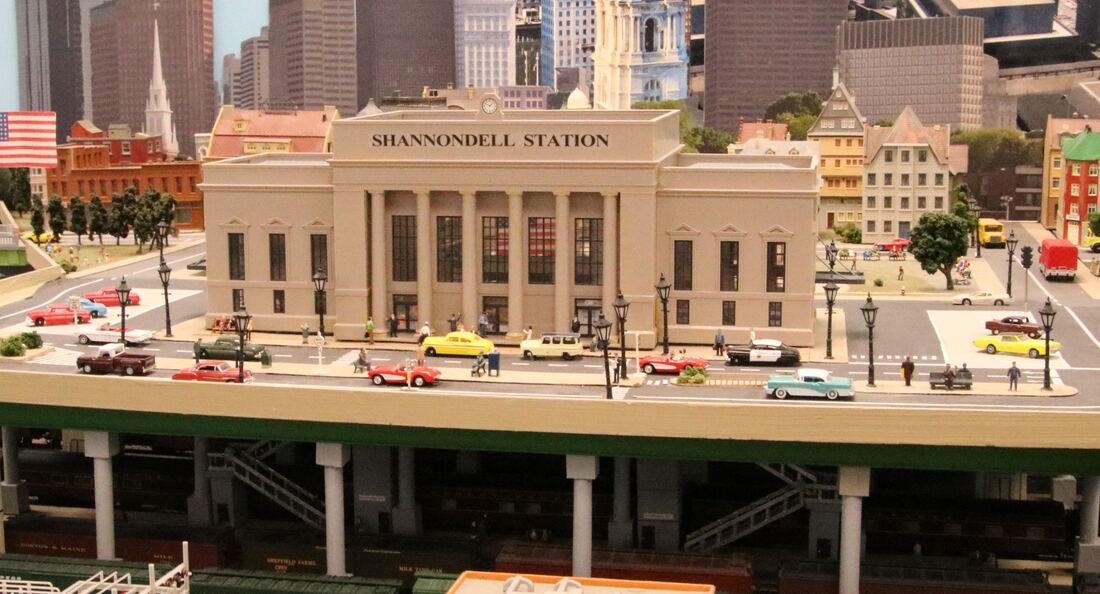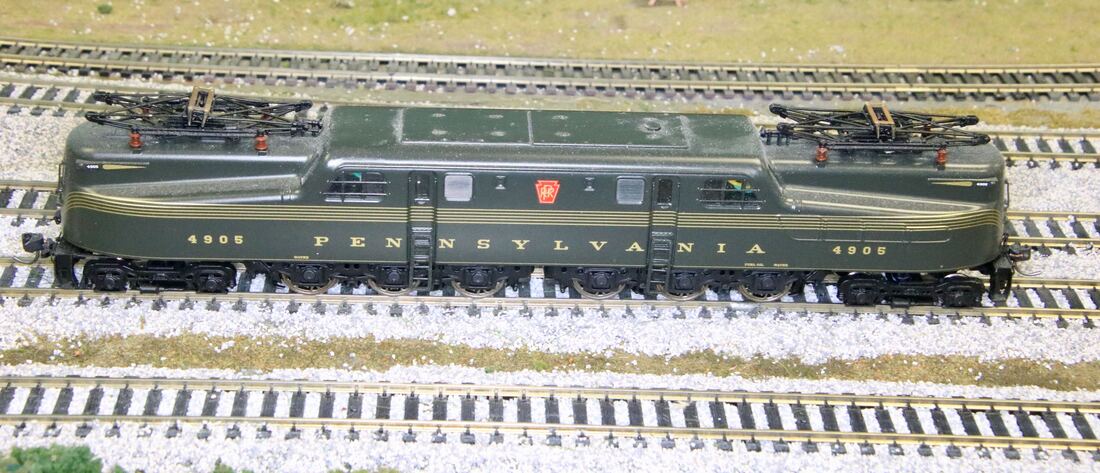Railroad Company History
Railroad company history is part of the history of transportation. Before railroads made their appearance, transport was achieved by foot, by horse and wagon or by boat.
Transport via roads (horse-drawn wagons over mostly dirt roads) proved difficult. Difficulties were exacerbated by rainy or snowy weather.
In general, boats could carry larger loads than horse-drawn wagons, but needed navigable waterways to operate (many froze in winter). Construction of canals (known in various forms for over 4,000 years) helped, but travel up and down hill required more than canals, even when equipped with locks. Tunnels can be used to solve the "hill and dale" problem, but they are expensive to build.
With the advent of high-pressure steam engines around 1790, a new and less expensive method of traveling up and down hill presented itself: the use of stationary steam engines to move material up hill and gravity or animal power to move it down hill. A famous example of such a system is the Allegheny Portage Railroad, extending from Hollidaysburg to Johnstown, Pennsylvania through the Blair Gap in the Allegheny Mountains, a short distance east of Cresson, PA. This railroad, part of the transportation system linking Philadelphia and Pittsburgh, PA, operated from 1834-1854 when it was rendered obsolete by steam-powered locomotives pulling freight and passenger trains across Pennsylvania.
The beginnings of what we now know as railroads arose about 1808 in England and around 1830 in the U.S.A.
In the following three sections, we briefly discuss the history of three railroad companies that are the central focus of Shannondell Model Railroad, namely the Reading Railroad, Lehigh Valley Railroad and Pennsylvania Railroad.
Reading Company

Although remembered mainly as a railroad, the Reading Company (https://www.american-rails.com/rdg.html, and https://en.wikipedia. org/wiki/Reading_Company) was, in its heyday, a multifaceted industrial giant operating as a holding company for a variety of enterprises. Originally established as The Philadelphia & Reading Railroad (P & R) in 1833 to transport anthracite coal, the pioneering 94-mile line evolved into a mighty corporation serving eastern Pennsylvania, New Jersey and Delaware.
Operations included coal mining, iron making, canal and sea-going transportation and shipbuilding. With its great complex of shops for locomotive and car building and repair, and constant advances in railroad technology, the company held a position of leadership in the railroad industry for over a century.
By the nature of the territory which it served, the P & R fueled the Industrial Revolution which led the United States to economic leadership. With lines reaching out in all directions, the P & R served the heart of the most densely industrialized area of the nation and by the 1870s became the largest corporation in the world.
During this period the P & R established a subsidiary, The P & R Coal and Iron Company, to gain control over the vast anthracite deposits being mined for shipment over its lines. As one of America’s first conglomerates, this attracted the infamous “robber barons” of the latter 1800s, such as Carnegie and Vanderbilt. During the company’s final spectacular attempt at expansion through control of lines to New England, Canada and the West, the formidable J. P. Morgan pulled the financial rug out from under The Reading Company, and forced the company to settle into its traditional role as a regional railroad – mainly a carrier of anthracite.
During the 1890s, to ward off government efforts to break up monopolies, the P & R’s owners created a new holding company named Reading Company, to own, on paper, the P & R Railroad and P & R Coal and Iron Co. Finally, a U. S. Supreme Court ruling forced a complete separation of the P & R entities. On January 1, 1924, the P & R Coal and Iron Co. became independent, and Reading Company became the railroad operating name.
After World War II, as America began to turn away from coal as its major fuel, the Reading’s fate began to turn as well. Dragged down by the failure of surrounding lines on which it depended for traffic to offset the loss of the coal business, the Reading entered bankruptcy in 1971. Its operations were taken over as part of the federally financed Consolidated Rail Corporation (CONRAIL), on April 1, 1976.
In 1962, the Reading Company purchased 20 GP30 locomotives built by the Electro-Motive Division of General Motors Corporation (EMD, now Electro-Motive Diesel), numbered them 5501 through 5520, and painted them in a distinctive green and yellow color scheme. One of the series, GP30 No. 5513, was placed on display for commuters inside the Reading Terminal in Philadelphia.
There were 948 GP30s built from 1961 to 1963. It is believed that only about eight still survive and some are still working. The Reading Company Technical & Historical Society owns No. 5513 and it is currently awaiting repair. Sadly, No. 5516 was scrapped in 1983 and No. 5518 in 1994.
Shannondell Model Railroad Club owns two model locomotives No. 5516 and No. 5518, as seen in the following figure. Come and see them in operation!
Lehigh Valley Railroad

The Lehigh Valley Railroad dates back to the mid-1800’s and was sometimes known as the Route of the Black Diamond, named after the anthracite coal it transported. The original purpose of its founders was to build a railroad for the transportation of anthracite and, incidentally perhaps, passengers between the mines then being operated near Mauch Chunk, PA (now Jim Thorpe), and the Delaware River at Easton, PA.
Almost immediately the railroad began to expand and by the 1890’s, the Lehigh Valley Railroad stretched from New York Harbor to Tifft Terminal in Buffalo, passing through the Lehigh Valley in Pennsylvania, and the Finger Lakes region of New York state.
By the mid-1900’s, steam had been replaced with diesel locomotives. Coal traffic declined steadily after the 1940s and, by 1962, the Pennsylvania Railroad had acquired majority stock control of Leigh Valley Railroad. On June 24, 1970, the Lehigh Valley Railroad declared bankruptcy, just three days following the bankruptcy of the Pennsylvania Railroad’s successor, Penn Central. Penn Central’s bankruptcy relieved them from paying fees to various Northeastern railroads, the Lehigh Valley included, for the use of their railcars and other operations. The non-payment of these fees was fatal to the Lehigh Valley Railroad’s finances.
The Lehigh Valley remained in operation during the 1970 bankruptcy. In 1972, the Lehigh Valley assumed the remaining Pennsylvania trackage of the Central Railroad of New Jersey, a competing anthracite railroad which had entered bankruptcy as well. In 1976, the assets of the bankrupt Lehigh Valley Railroad were acquired by Consolidated Rail Corporation (CONRAIL).
Almost immediately the railroad began to expand and by the 1890’s, the Lehigh Valley Railroad stretched from New York Harbor to Tifft Terminal in Buffalo, passing through the Lehigh Valley in Pennsylvania, and the Finger Lakes region of New York state.
By the mid-1900’s, steam had been replaced with diesel locomotives. Coal traffic declined steadily after the 1940s and, by 1962, the Pennsylvania Railroad had acquired majority stock control of Leigh Valley Railroad. On June 24, 1970, the Lehigh Valley Railroad declared bankruptcy, just three days following the bankruptcy of the Pennsylvania Railroad’s successor, Penn Central. Penn Central’s bankruptcy relieved them from paying fees to various Northeastern railroads, the Lehigh Valley included, for the use of their railcars and other operations. The non-payment of these fees was fatal to the Lehigh Valley Railroad’s finances.
The Lehigh Valley remained in operation during the 1970 bankruptcy. In 1972, the Lehigh Valley assumed the remaining Pennsylvania trackage of the Central Railroad of New Jersey, a competing anthracite railroad which had entered bankruptcy as well. In 1976, the assets of the bankrupt Lehigh Valley Railroad were acquired by Consolidated Rail Corporation (CONRAIL).
The black and white diesel locomotives No. 638 and No. 639 were purchased for the SMRC by one of its members, Glenn Landis. They are in remembrance of his father, Edwin C. Landis, who worked for the Lehigh Valley Railroad for fifty years (1916-1966). He died in 1998 at the age of 104.
During Glenn’s early teenage years, he spent a lot of time after school with his father in the marshalling yards where the freight trains were put together for trips all over the country. He also accompanied his father on passenger runs from Easton to Buffalo and Glenn developed a keen interest in everything about the railroad. After a near accident on Glenn’s part when his foot slipped while he was climbing a ladder on a moving boxcar and came within inches of the wheel, his father discouraged any further thought about a railroad career.
Locomotives #638 and #639 were built by ALCO as part of the Century Series. These C-628s were 6 axle, 2800 hp diesel locomotives of the road switch type. ALCO built 186 of these between 1963 and 1967. The locomotives numbered 638 and 639 were delivered to the Lehigh Valley Railroad in December of 1967 and were painted in the black and white livery (called 'snow birds'). In March of 1973, they were re-painted Cornell Red (after one of the Cornell University colors) with a yellow stripe. By 1980, all of the ALCO C-628 diesel locomotives had been scrapped.
SMRC is pleased to have the two model locomotives pictured below: Numbers 641 and 632. Come see them in operation on the Shannondell Model Railroad.
Pennsylvania Railroad

The Pennsylvania Railroad Company (reporting mark PRR) began life in 1846 with the purpose of building a railroad line connecting Harrisburg with Pittsburgh, PA. Competition was offered by the Baltimore and Ohio Railroad, but the Pennsy won out and Letters Patent were issued by Pennsylvania governor Francis R. Shunk in 1847.
The line connecting Pittsburgh and Harrisburg was completed in 1854 and included the Allegheny Tunnel of about 3,600 feet (1097 m) length at an elevation of nearly 2,200 feet (670 m) above mean sea level. A second tunnel was constructed by the Commonwealth of Pennsylvania for the New Portage Railroad. East of these tunnels is the famous Horseshoe Curve built using a combination of cuttings and fills to maintain a grade of less than 2%.
PRR contracted with the Harrisburg, Portsmouth, Mountjoy and Lancaster Railroad (HPMtJ&L) in 1848 and was subsequently granted trackage rights over the Philadelphia and Columbia Railroad (P&CR), thereby giving PRR a route under its sole control from Philadelphia to Pittsburgh by 1861.
The Pennsy continued to expand in all directions. The company either purchased or entered into long-term leases with many other railroads so that by 1893 it had access to many parts of the United States and would become the largest railroad (by traffic and revenue), the largest transportation enterprise, and the largest corporation in the world (see The Pennsylvania Railroad, Volume 1: Building an Empire, 1846–1917). By 1927, the PRR operated more than 11,000 miles of track.
Pennsy built the Altoona Works beginning 1850 to perform maintenance and construction of locomotives, railroad cars and parts. By 1945 Altoona Works was the largest operation of its kind in the world. It is still a significant operation now owned by Norfolk Southern (NS).
PRR is well-known for the stations or terminals it built, most of which are still in use. Among these are Broad Street Station, Philadelphia (1881 -- since demolished); Union Station, Washington, D.C. (1908); Penn Station, New York (1910) and Philadelphia's William H. Gray III 30th Street Station (1933). SMRC's Shannondell Station is loosely modeled on 30th Street Station, as can be seen in the following illustration.
PRR's main line from Philadelphia to Pittsburgh was originally a 4-track line. It is for this reason PRR christened one of its passenger fleet the Broadway Limited (1912) operating from New York to Chicago; It was originally the Pennsylvania Limited (1877) then the Pennsylvania Special (1902). Today the main line is reduced to two lines much of its length.
PRR was the first railroad to employ steel rails (rather than iron) beginning in 1865 and in 1872 air brakes were introduced.
Another advance involved electrification of rail lines which began in 1910, motivated by a New York law that prohibited steam power because of its polluting nature. Philadelphia was soon also electrified and by 1915 the main line to Paoli had been electrified. By 1935, what is now known as the Northeast Corridor (New York to Washington , DC) was electrified and by 1938, many branch lines, as well as Paoli to Harrisburg were electrified. Pennsy employed several different electric locomotives (fed by a third rail in New York and by overhead lines elsewhere). SMRC owns two model GG1 locomotives, numbered 4905 and 4929. One of these is seen in the following image.
PRR was the first railroad to employ steel rails (rather than iron) beginning in 1865 and in 1872 air brakes were introduced.
Another advance involved electrification of rail lines which began in 1910, motivated by a New York law that prohibited steam power because of its polluting nature. Philadelphia was soon also electrified and by 1915 the main line to Paoli had been electrified. By 1935, what is now known as the Northeast Corridor (New York to Washington , DC) was electrified and by 1938, many branch lines, as well as Paoli to Harrisburg were electrified. Pennsy employed several different electric locomotives (fed by a third rail in New York and by overhead lines elsewhere). SMRC owns two model GG1 locomotives, numbered 4905 and 4929. One of these is seen in the following image.
Between the late 1940s to 1957, the Pennsylvania Railroad converted most of its motive power from steam to diesel-electric. The new diesel-electric locomotives required less maintenance than did the steam-powered ones. They were also cheaper to operate and produced much less pollution. Nevertheless, PRR was coming to an end.
For a variety of reasons, including competitors such as air transport, highway transport (particularly because of ease of effecting delivery the "last mile"), management miscalculations, government regulations and weather, railroads were experiencing significant business downturn. Finally, the Pennsylvania Railroad and New York Central (its chief railroad competitor) merged to form the Penn Central Transportation Company in 1968. Penn Central only lasted about two years before filing for bankruptcy. Together with failure of other notable railroads, such as Lehigh Valley and Reading (both around 1970) the United Stated Congress stepped in, authorized United States Railway Association (USRA) to formulate a plan to consolidate the several railroads in receivership. In 1976, Consolidated Rail Corporation (CONRAIL) took over operation of more than a dozen railroads, including the Pennsylvania Railroad.
Conrail was later largely divided between CSX Transporation (CSXT) and Norfolk Southern Railway (NS). Passenger service was transferred to Amtrak (National Railroad Passenger Corporation) in 1971.
The history of selected locomotives employed by the three railroad companies discussed above is presented in Locomotive History.







